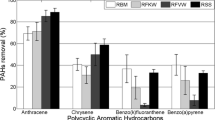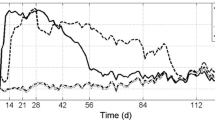Abstract
One of the possible ways of recovering the environmental quality of contaminated soils is the bioremediation process, in which soil pollutants are degraded using microorganisms. In this context, the evaluation of the bioremediation process efficiency was evaluated by preparing a consortium of autochthonous microorganisms of the soil from an area contaminated by wood preservatives. Subsequently, biodegradation experiments were performed on microcosm scale, applying bioaugmentation, enrichment and biostimulation techniques in two inoculums. The experiments were monitored by CO2 production and the presence of total polycyclic aromatic hydrocarbons (PAHs). Organic extracts of this soil were prepared before and after being submitted to bioremediation, in which the 16 PAHs considered priority pollutants by USEPA were analyzed, and compared to the responses found for microbial respiration. The initial concentration of the PAHs was 34 mg/Kg. All the treatments achieved a removal rate above 60 %, and the mean degradation was 88 %. Statistical analyses of the results of CO2 production showed a significant difference between all treatments for the control soil, except inoculum 1 (bioaugmented). However, inoculums 1 and 2 present a more efficient performance than the contaminated soil itself. When inoculums 1 and 2 (bioaugmented, biostimulated, and enriched) were compared, inoculum 2 presented a greater evolution of CO2 and a better performance in PAHs degradation. Therefore, it was more efficient in the experiment. Hence, as the best results were obtained with the inoculum whose mixed culture had been enriched, this technique definitely has a greater potential for biodegradation in bioremediation processes with these contaminants.




Similar content being viewed by others
References
Aitken, M. D., Stringfellow, W. T., Nagel, R. D., Kazunga, C., & Chen, S. H. (1998). Characteristics of phenanthrene-degrading bacteria isolated from soils contaminated with polycyclic aromatic hydrocarbons. Can J Microbiol, 44, 743–752.
Bartha, R., & Pramer, D. (1965). Features of a flask and method for measuring the persistence and biological effects of pesticides. Soil Sci, 100, 68–70.
Boonchan, S., Britz, M. L., & Stanley, G. A. (2000). Degradation and mineralization of high-molecular-weight polycyclic aromatic hydrocarbons by defined fungal-bacterial cocultures. Appl Environ Microbiol, 66(3), 1007–1019.
Cerniglia, C. E. (1992). Biodegradation of polycyclic aromatic hydrocarbons. Biodegradation, 3, 351–368.
CETESB. (1990). COMPANHIA DE TECNOLOGIA DE SANEAMENTO AMBIENTAL Norma Técnica L6.350 - Solos – Determinação da Biodegradação de Resíduos – Método Respirométrico de Bartha (p. 9). São Paulo.
EMBRAPA. (1997). Empresa Brasileira de Pesquisa Agropecuária (Manual de métodos de análise do solo 2nd ed.). Rio de Janeiro: EMBRAPA CNPS. 212p.
FEPAM/CNPq. (2010). Estratégias ecotoxicológicas para caracterizar áreas contaminadas como medida de risco à saúde populacional. Porto Alegre: FEPAM. Project 555187/2006-3.
Gaylarde, C. C., Bellinaso, M. D. L., & Manfio, G. P. (2005). Biotecnologia Ciência & Desenvolvimento. 34. janeiro/junho.
Gillespie, I. M. M., & Philp, J. C. (2013). Biotechnology policy series. Bioremediation and environmental remediation, technology for the bioeconomy. Trends Biotechnol, 31(6), 329–332.
Giraud, F., Guiraud, P., Kadri, M., Blake, G., & Steiman, R. (2001). Biodegradation of anthracene and fluoranthene by fungi isolated from an experimental constructed wetland for wastewater treatment. Water Res, 35(17), 4126–4136.
Guerin, T. F. (1999). Bioremediation of phenols and polycyclic aromatic hydrocarbons in creosote contaminated soil using ex-situ land treatment. J Hazard Mater, 65(3), 305–315.
Haritash, A. K., & Kaushik, C. P. (2009). Biodegradation aspects of polycyclic aromatic hydrocarbons (PAHs): a review. J Hazard Mater, 169, 1–15.
Jacques, R. J. S., et al. (2005). Anthracene biodegradation by Pseudomonas sp isolated from a petrochemical sludge landfarming. Int Biodeterior Biodegrad, 56(3), 150–156.
Jacques, R. J. S., Bento, F. M., Antoniolli, Z. I., & Camargo, F. A. O. (2007). Biorremediação de solos contaminados com hidrocarbonetos aromáticos policíclicos. Ciência Rural, 37(4), 1192–1201.
Johnsen, A. R., & Karlson, U. (2007). Diffuse PAH contamination of surface soils: environmental occurrence, bioavailability, and microbial degradation. Appl Microbiol Biotechnol, 76, 533–543.
Juhasz, A. L., Britz, M. L., & Stanley, G. A. (1997). Degradation of fluoranthene, pyrene, benz[a] anthracene and dibenz [a, h] anthracene by Burkholderia cepacia. J Appl Microbiol, 83, 189–198.
Kanaly, R. A., & Bartha, R. (1999). Cometabolic mineralization of benzo[a]pyrene caused by hydrocarbon additions to soil. Environ Chem, 18(10), 2186–2190.
Kim, Y. M., Ahn, C. K., Woo, S. H., Jung, G. Y., & Park, J. M. (2009). Synergic degradation of phenanthrene by consortia of newly isolated bacterial strains. J Biotechnol, 144, 293–298.
Kiyohara, H., Torigoe, S., Kaida, N., Asaki, T., Iida, T., Hayashi, H., & Takizawa, N. (1994). Cloning and characterization of a chromosomal gene cluster, PAH, that encodes the upper pathway for phenanthrene and naphthalene utilization by pseudomonas putida OUS82. J Bacteriol, 176(8), 2439–2443.
Kottler, B. D., & Alexander, M. (2001). Relationship of properties of polycyclic aromatic hydrocarbons to sequestration in soil. Environ Pollut, 113, 293–298.
Li, X., Li, P., Lin, X., Zhang, C., Li, O., & Gong, Z. (2008). Biodegradation of aged polycyclic aromatic hydrocarbons (PAHs) by microbial consortia in soil and slurry phases. J Hazard Mater, 150(1), 21–26.
Li, X., Lin, X., Li, P., Liu, W., Wang, L., Ma, F., & Chukwuka, K. S. (2009). Biodegradation of the low concentration of polycyclic aromatic hydrocarbons in soil by microbial consortium during incubation. J Hazard Mater, 172, 601–605.
Lladó, S., Covino, S., Solanas, A. M., Vinas, M., Petruccioli, M., & D’Annibaled, A. (2013a). Comparative assessment of bioremediation approaches to highly recalcitrant PAH degradation in a real industrial polluted soil. J Hazard Mater. doi:10.1016/j.jhazmat.2013.01.020.
Lladó, S., Gràcia, E., Solanas, A. M., & Viñas, M. (2013b). Fungal and bacterial microbial community assessment during bioremediation assays in an aged creosote-polluted soil. Soil Biol Biochem, 67, 114–123.
Lundstedt, S. (2003). Analysis of PAHs and their transformation products in contaminated soil and remedial processes. Umea: Department of Chemistry Environmental Chemistry Umeå University SE-901 200387.
Mariano, A. P., Angelis, D. F., Pirôllo, M. P. S., Contiero, J., & Bonotto. (2009). Investigation about the efficiency of the bioaugmentation technique when applied to diesel oil contaminated soils. Braz Arch Biol Technol, 52(5), 1297–1312.
Megharaj, M., Ramakrishnane, B., Venkateswarlu, K., Sethunathan, N., & Naidu, R. (2011). Bioremediation approaches for organic pollutants: a critical perspective. Environ Int, 37, 1362–1375.
Mizwar, A., & Triha, Y. (2015). PAH contamination in soils adjacent to a coal-transporting facility in Tapin district, south Kalimantan, Indonesia. Arch Environ Contam Toxicol, 69, 62–68.
Moscoso, F., Teijiz, I., Deive, F. J., & Sanroman, M. A. (2012). Efficient PAHs biodegradation by bacterial consortium at flask and bioreactor scale. Bioresour Technol, 119, 270–276.
NBR 14283. (1999). Resíduos em solos: determinação da biodegradação pelo método respirométrico. RJ.
Pohren, R., Rocha, J., Leal, K., & Vargas, V. (2012). Soil mutagenicity as a strategy to evaluate environmental and health risks in a contaminated area. Environ Int, 44, 40–52.
Posada-Baquero, R., & Ortega-Calvo, J. J. (2011). Recalcitrance of polycyclic aromatic hydrocarbons in soil contributes to background pollution. Environ Pollut, 159, 3692–3699.
Rahman, K. S. M., Thahira, J., Kourkoutas, Y., Petsas, I., Marchant, R., & Banat, I. M. (2003). Enhanced bioremediation of n-alkane in petroleum sludge using bacterial consortium amended with rhamnolipid and micronutrients. Bioresour Technol, 90(2), 159–168.
Sayara, T., Borràs, E., Caminal, G., Sarràa, M., & Sáncheza, A. (2011). Bioremediation of PAHs-contaminated soil through composting: influence of bioaugmentation and biostimulation on contaminant biodegradation. Int Biodeter Biodegr, 65, 859–865.
Semple, K. T., Kieron, J. D., Wick, L. Y., & Harms, H. (2007). Microbial interactions with organic contaminants in soil: definitions, processes and measurement. Environ Pollut, 150, 166–176.
Serrano, I. S., dos Santos, E. C., Menezes, C. R., de Faria, A. F., Franciscon, E., Grossman, M., & Durrant, L. R. (2009). Bioremediation of a polyaromatic hydrocarbon contaminated soil by native soil microbiota and bioaugmentation with isolated microbial consortia. Bioresour Technol, 100, 4669–4675.
Standard methods for the examination of water wastewater. (1995). American Public Health Association/American water Works Association/Water Environment Federation, Washington (19th ed.)
Sun, R., Jin, J., Sun, G., Liu, Y., & Liu, Z. (2010). Screening and degrading characteristics and community structure of a high molecular weight polycyclic aromatic hydrocarbon-degrading bacterial consortium. J Environ Sci, 22(10), 1576–1585.
Trindade, P. V., Sobral, L. G., Rizzo, A. C., Leite, S. G., & Soriano, A. U. (2005). Bioremediation of a weathered and a recently oil-contaminated soils from Brazil: a comparison study. Chemosphere, 58(4), 515–522.
Trzesicka-Mlynarz, D., & Ward, O. P. (1995). Degradation of polycyclic aromatic hydrocarbons (PAHs) by a mixed culture and its component pure cultures, obtained from PAH-contaminated soil. Can J Microbiol, 41, 470–476.
USEPA-U.S. Environmental Protection Agency. (1996a). Method 8270C: semivolatile organic compounds by gas chromatography/mass spectrometry (GC/MS).
USEPA-U.S. Environmental Protection Agency. (1996b). Soil screening guidance: user´s guide. Publication 9355.4-23 (p. 39). Washington, DC: Office of Solid Waste and Emergency Response.
USEPA-U.S. Environmental Protection Agency. (2007). Method 3550C, Ultrasonic extraction. . http://www.epa.gov/sw846/pdfs/3500.pdf
White, P. A., Lemieux, C. L., Lynes, K. D., Lambert, I. B., Öberg, L., Haglund, P., & Tysklind, M. (2007). Sources, fate, and toxic hazards of oxygenated polycyclic aromatic hydrocarbons (PAHs) at PAH-contaminated sites. AMBIO, 36(6), 475–485.
Zafra, G., & Cortés-Espinosa, D. V. (2015). Biodegradation of polycyclic aromatic hydrocarbons by Trichoderma species: a mini review. Environ Sci Pollut Res. doi:10.1007/s11356-015-5602-4.
Acknowledgments
Our appreciation goes to CAPES for the PhD fellowship, to the Post-Graduate Program in Ecology at UFRGS; to Márcio Olivio Rozin, to Nair Conde Almeida, and Richard Tomasella from UNESP in Rio Claro/SP for helping to set up and implement the respirometry assays and clear technical doubts; to Dr. Carlos E Levy of UNICAMP/SP for the initial identification of the bacteria; to Dr. Derlene Attili de Angelis, also of UNICAMP/SP; and to Prof. Jandyra Fachel, Gilberto P. Mesquita, and Sídia Maria Callegari Jacques for performing the statistical analyses.
Author information
Authors and Affiliations
Corresponding author
Rights and permissions
About this article
Cite this article
de Souza Pohren, R., de Oliveira Leite, D.A.N., de Franceschi de Angelis, D. et al. Performance of Simulated Bioremediation in Real Samples of Soils Contaminated with PAHs. Water Air Soil Pollut 227, 330 (2016). https://doi.org/10.1007/s11270-016-2939-3
Received:
Accepted:
Published:
DOI: https://doi.org/10.1007/s11270-016-2939-3




